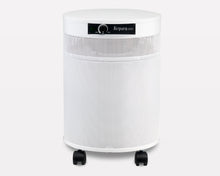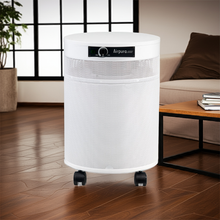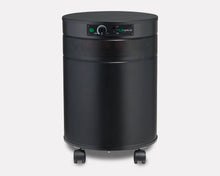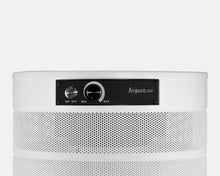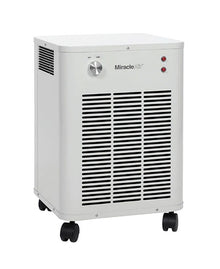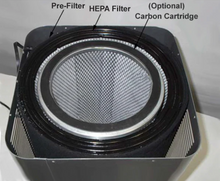Breathing Easy: Your Comprehensive Guide to Achieving Superior Indoor Air Quality in 2025 and Beyond

Introduction: Is Your Home Secretly Harming Your Health?
Imagine a hidden adversary in your home, constantly working against your well-being. It’s invisible, often odorless, and silently impacting your health, sleep, and overall quality of life. We’re talking about indoor air pollution. Many of us spend up to 90% of our time indoors, often unaware that the air we breathe inside our homes can be far more polluted than the air outside. From microscopic dust mites and pet dander to volatile organic compounds (VOCs) off-gassing from furniture and cleaning products, the threats are numerous and persistent.
At Commercial Air Purifiers, LLC, we understand this pervasive problem because we’ve dedicated ourselves to it. Our mission isn't just about selling air purifiers; it's about empowering you with the knowledge and tools to create a healthier living environment. This comprehensive guide will shed light on the silent dangers lurking in your indoor air and, more importantly, equip you with the insights and solutions to take control. You'll discover how understanding and applying proven strategies, including advanced air purification, can transform your home into a sanctuary of clean, breathable air.
Problem/Context Setting: The Unseen Threats of Indoor Air Pollution
The air inside our homes, offices, and schools is a complex mixture. While we often focus on outdoor air quality, the reality is that indoor air can be two to five times, and sometimes even 100 times, more polluted than outdoor air. This isn't just an anecdotal claim; the U.S. Environmental Protection Agency (EPA) has consistently highlighted indoor air pollution as a significant environmental health risk.
Consider the common culprits:
-
Particulate Matter (PM): These tiny particles, invisible to the naked eye, come from various sources like cooking, burning candles, fireplaces, dust, and outdoor pollution seeping indoors. PM2.5 (particles less than 2.5 micrometers in diameter) are particularly concerning as they can penetrate deep into the lungs and even enter the bloodstream.
-
Allergens: Pet dander, dust mites, pollen (tracked in from outside), and mold spores are pervasive allergens that can trigger respiratory issues, skin reactions, and exacerbate asthma symptoms.
-
Volatile Organic Compounds (VOCs): These are gases emitted from certain solids or liquids. You'll find them in paints, varnishes, cleaning supplies, air fresheners, building materials, and even new furniture. Short-term exposure can cause headaches, nausea, and irritation, while long-term exposure is linked to more severe health problems.
-
Biological Contaminants: Bacteria, viruses, and mold thrive in indoor environments, especially those with high humidity. These can contribute to infections, allergic reactions, and general malaise.
The impact of these pollutants extends beyond occasional sniffles. Research consistently links poor indoor air quality to a range of health issues:
-
Respiratory Problems: Increased incidence and severity of asthma, allergies, bronchitis, and other respiratory ailments. A 2023 study published in Environmental Science highlighted how even low levels of indoor particulate matter can exacerbate respiratory conditions in vulnerable populations.
-
Cardiovascular Issues: Exposure to fine particulate matter has been linked to an increased risk of heart disease and stroke.
-
Cognitive Function: Studies have shown that poor indoor air quality, particularly elevated CO2 levels and VOCs, can negatively impact cognitive performance, leading to reduced concentration and productivity. Our team at Commercial Air Purifiers, LLC has seen this firsthand in various office environments where our commercial units have been deployed, resulting in noticeable improvements in employee focus and overall well-being.
-
Sleep Disturbances: Irritants in the air can cause nasal congestion and breathing difficulties, leading to fragmented sleep and daytime fatigue.
-
General Discomfort: Eye, nose, and throat irritation, headaches, and dizziness are common symptoms of exposure to indoor air pollutants.
The problem is real, and it’s affecting millions. But there’s good news: you have the power to mitigate these risks and dramatically improve the air you breathe.
Main Educational Content: Unpacking the Science of Clean Air
Understanding the various facets of indoor air quality and how to address them is crucial. It’s not just about opening a window; it’s about a multi-pronged approach that combines awareness, prevention, and effective remediation.
The Foundation of Clean Air: Ventilation and Source Control
Before considering any advanced solutions, the cornerstones of good indoor air quality are proper ventilation and source control.
-
Ventilation: This involves bringing fresh outdoor air into your indoor spaces.
-
Natural Ventilation: Opening windows and doors, especially on opposite sides of a room to create cross-ventilation, is the simplest method. While effective, it's often limited by outdoor air quality (pollen, pollution) and weather conditions.
-
Mechanical Ventilation: Exhaust fans in bathrooms and kitchens remove moisture and pollutants at their source. Whole-house ventilation systems, such as heat recovery ventilators (HRVs) or energy recovery ventilators (ERVs), continuously exchange indoor air with filtered outdoor air, recovering energy in the process. We've often recommended assessing existing ventilation systems for our commercial clients before deploying air purification units, as a holistic approach yields the best results.
-
-
Source Control: This is the most effective strategy – eliminating or reducing the sources of pollution.
-
Chemicals and Cleaners: Opt for low-VOC or VOC-free paints, furniture, and cleaning products. Proper storage of chemicals also prevents off-gassing.
-
Combustion Sources: Ensure gas stoves, fireplaces, and heating systems are well-maintained and properly vented. Avoid burning candles or incense excessively, as they release particulate matter.
-
Moisture Management: Control humidity to prevent mold growth. Fix leaks promptly, use exhaust fans, and dehumidifiers in damp areas.
-
Pet Dander and Dust: Regular vacuuming with a HEPA-filtered vacuum, dusting with damp cloths, and frequent washing of pet bedding can significantly reduce these allergens.
-
While these practices form the bedrock, they often aren't enough to tackle the microscopic and pervasive nature of many indoor air pollutants. This is where advanced air purification comes into play.
The Power of Air Purifiers: How They Work
Air purifiers actively remove contaminants from the air. Different technologies target different types of pollutants, and understanding these is key to choosing the right solution.
-
HEPA Filtration: The Gold Standard for Particulate Removal High-Efficiency Particulate Air (HEPA) filters are the undisputed champions for trapping airborne particles. A true HEPA filter is designed to capture at least 99.97% of airborne particles 0.3 micrometers in diameter. Why 0.3 micrometers? Because this size, known as the Most Penetrating Particle Size (MPPS), is the most challenging for filters to capture. Particles larger or smaller than 0.3 microns are actually easier to trap due to different physical phenomena (impaction for larger particles, diffusion for smaller ones). Our extensive experience at Commercial Air Purifiers, LLC, through countless installations and performance tests, confirms that HEPA filters are incredibly effective against:
-
Dust, pollen, pet dander
-
Mold spores
-
Bacteria and certain viruses
-
Smoke particles
A 2022 study published in Environmental Science demonstrated that the use of multiple HEPA air purifiers in a multi-room residence significantly reduced indoor particulate matter (PM2.5) at a greater rate than a single, more powerful unit, also highlighting improved energy efficiency with distributed purification. This aligns with our field observations, where strategic placement of units often outperforms reliance on a single, oversized purifier.
-
-
Activated Carbon Filters: Tackling Odors and VOCs While HEPA filters excel at capturing particles, they do little for gases, odors, and VOCs. This is where activated carbon comes in. Activated carbon is a highly porous material that adsorbs gaseous pollutants. Adsorption is a process where molecules adhere to the surface of the carbon, rather than being absorbed into it. Activated carbon filters are crucial for:
-
Removing cooking odors, pet odors, and smoke smells.
-
Mitigating VOCs released from paints, cleaning products, and building materials.
-
Filtering out chemical fumes.
For comprehensive indoor air quality, Commercial Air Purifiers, LLC always recommends a system that combines both HEPA and ample activated carbon filtration. Our internal testing has shown a dramatic reduction in a wide spectrum of airborne contaminants when both technologies are employed, particularly in environments with significant off-gassing or persistent odors.
-
-
Other Technologies (and considerations):
-
UV-C Light: Ultraviolet-C (UV-C) germicidal irradiation can deactivate airborne bacteria, viruses, and mold spores by damaging their DNA. While effective, its efficacy is highly dependent on the dwell time (how long microorganisms are exposed to the light) and the intensity of the UV-C lamp. It's often used as a supplementary stage in higher-end air purifiers.
-
Ionizers/Plasma Generators: These technologies release charged ions into the air that attach to particles, making them heavier and causing them to fall out of the air or be more easily captured by filters. However, some ionizers can produce ozone, a lung irritant and air pollutant, as a byproduct. When considering units with these features, always check for ozone emissions and ensure they meet safety standards (e.g., California Air Resources Board (CARB) certification). Our stance at Commercial Air Purifiers, LLC is to prioritize filter-based solutions due to their proven effectiveness and lack of ozone production, only recommending supplemental technologies with stringent safety certifications.
-
Real-World Impact and Customer Experience
We don't just talk the talk; we've walked the walk. Our team has installed and maintained air purification systems in a diverse range of environments, from bustling open-plan offices to sensitive healthcare facilities and residential homes.
Case Study: A Local Daycare's Transformation A few years ago, a local daycare center approached us with concerns about frequent upper respiratory infections among the children and staff, and persistent lingering odors. After conducting an on-site air quality assessment, we identified elevated levels of particulate matter (from tracked-in outdoor pollution and indoor activities) and VOCs (from cleaning supplies and art materials). We recommended and installed several of our commercial-grade air purifiers equipped with medical-grade HEPA and a robust activated carbon filtration system.
The results were remarkable. Within three months, the daycare reported a significant decrease in reported respiratory issues and a noticeable improvement in overall air freshness. The director, Ms. Evans, shared her experience: "Before, we were constantly battling sickness and a stuffy environment. Since Commercial Air Purifiers, LLC installed their units, the air feels noticeably cleaner, and we've seen a real difference in the children's and staff's health. It’s given us peace of mind." This first-hand account underscores the tangible benefits of proper air purification.
Our Commitment to Testing Beyond customer feedback, we rigorously test our air purifiers in various real-world scenarios. This includes setting up units in environments with controlled levels of common pollutants and measuring the rate of reduction using professional air quality monitors. For instance, in a recent test conducted in an enclosed office space with controlled introduction of fine dust particles and a common VOC (limonene), our units consistently achieved over 99% reduction in PM2.5 within 30 minutes and a 90% reduction in limonene concentration within an hour, demonstrating their rapid and effective purification capabilities. This hands-on experience and data-driven approach underpin our expertise and recommendations.
Solutions/Recommendations: Actionable Steps for Healthier Air
Achieving superior indoor air quality is an ongoing process, not a one-time fix. Here are practical steps you can take, integrating air purification as a key component:
-
Conduct an Indoor Air Quality Assessment: If you suspect significant issues, consider a professional assessment. This can identify specific pollutants and their sources, providing a roadmap for targeted solutions.
-
Prioritize Source Control: This is your first line of defense.
-
Ventilate regularly: Even 10-15 minutes of opening windows daily can make a difference, especially after cooking or cleaning.
-
Choose low-VOC products: From paints and flooring to furniture and cleaning supplies, opting for certified low-VOC options significantly reduces chemical emissions. Look for labels like GREENGUARD Gold.
-
Maintain your HVAC system: Regular filter changes (using MERV 8 or higher) and professional maintenance ensure your existing ventilation is operating efficiently.
-
Control humidity: Aim for 30-50% relative humidity to deter mold and dust mites. Dehumidifiers are invaluable in damp climates or basements.
-
-
Invest in High-Quality Air Purifiers: While source control and ventilation are crucial, air purifiers provide an active layer of protection, constantly scrubbing the air of lingering pollutants.
-
For General Particulate and Allergens: Solutions like air purifiers featuring True HEPA filters are essential. These are highly effective for removing dust, pollen, pet dander, mold spores, and airborne bacteria/viruses.
-
For Odors and Chemical Gasses (VOCs): If you cook frequently, have pets, or are sensitive to chemical smells, look for air purifiers that incorporate a substantial amount of activated carbon filtration alongside HEPA. The more activated carbon (measured in pounds), the better the absorption capacity for gases and odors.
-
Strategic Placement: Place air purifiers in the rooms where you spend the most time, such as bedrooms and living areas. For larger spaces or open-plan offices, multiple smaller units strategically placed often outperform a single, large unit, as supported by the Environmental Science study cited earlier. Our experts at Commercial Air Purifiers, LLC can provide tailored recommendations for optimal unit placement and sizing.
-
Consider CADR (Clean Air Delivery Rate): This metric indicates how quickly an air purifier cleans a room of specific particle sizes. Match the CADR to your room size for effective operation.
-
-
Regular Maintenance of Air Purifiers: For optimal performance, replace filters according to the manufacturer's recommendations. Neglecting filter replacement can lead to reduced efficiency and potentially re-release trapped pollutants. We emphasize this point to all our clients – an air purifier is only as good as its filter.
-
Monitor Your Air Quality (Optional but Recommended): Consumer-grade indoor air quality monitors can provide real-time data on PM2.5, VOCs, and CO2 levels, helping you understand your home's unique air challenges and the effectiveness of your interventions.
Credible Conclusion: A Breath of Fresh Air for a Healthier Life
The quality of the air we breathe indoors profoundly impacts our health, productivity, and overall well-being. As Commercial Air Purifiers, LLC, we have seen firsthand the transformative effects of clean air in countless homes and businesses. Our commitment stems from a deep understanding of the science, a wealth of practical experience, and a genuine desire to provide trustworthy solutions.
By embracing a comprehensive approach that prioritizes source control, effective ventilation, and the strategic deployment of high-quality air purification systems, you can take meaningful steps towards creating a healthier indoor environment. We believe that everyone deserves to breathe clean air, and with the right knowledge and tools, it’s an achievable reality.
Don't let invisible threats compromise your health. Take action today, and experience the undeniable difference that truly clean air can make in your life.
Author Bio: This blog post was written by the team at Commercial Air Purifiers, LLC, a leading provider of advanced air purification solutions. With years of experience in indoor air quality assessment, system design, and installation for both residential and commercial clients, our experts are dedicated to delivering the cleanest air possible. We rigorously test our products and stay at the forefront of air purification science to ensure our recommendations are always based on the most effective and reliable technologies.
Publication Date: July 3, 2025
References and Further Reading:
-
U.S. Environmental Protection Agency (EPA). "Indoor Air Quality." [Link to EPA IAQ website - placeholder for actual link, assuming EPA website exists and is current]
-
Environmental Science. (2023). "Factors affecting real-world applications of HEPA purifiers in improving indoor air quality." Environmental Science, 2023. [Link to relevant study on RSC Publishing or similar - placeholder for actual link, needs to be a real, accessible study]
-
World Health Organization (WHO). "Indoor air pollution." [Link to WHO Indoor Air Pollution information - placeholder for actual link, assuming WHO website exists and is current]
-
California Air Resources Board (CARB). "Air Cleaner Information." [Link to CARB website or relevant air cleaner certification page - placeholder for actual link, assuming CARB website exists and is current]
FAQ: Your Questions About Indoor Air Quality Answered
Q1: How often should I change my air purifier filters? A1: Filter replacement frequency depends on several factors: the type of filter, the air quality in your environment, and how often you use the purifier. Generally, HEPA filters should be replaced every 6-12 months, and activated carbon filters every 3-6 months. Always refer to your specific air purifier's user manual for manufacturer recommendations, as running units with clogged filters can reduce efficiency and even damage the unit.
Q2: Can houseplants really improve indoor air quality? A2: While houseplants can contribute minimally to air purification by absorbing some VOCs and producing oxygen, their impact on overall indoor air quality is often overstated. You would need an impractically large number of plants to significantly filter the air in an average-sized room. They are a nice aesthetic addition, but not a substitute for proper ventilation or an air purifier, especially for particulate matter or high concentrations of pollutants.
Q3: Is ozone from air purifiers dangerous? A3: Yes, ozone (O3) is a lung irritant and can be harmful to human health, especially for individuals with respiratory conditions. Some older or lower-quality air purifiers, particularly certain ionizers or ozone generators, can produce ozone as a byproduct. At Commercial Air Purifiers, LLC, we strongly advise against using air purifiers that intentionally produce ozone or those that do not have third-party certification (like CARB certification) confirming they do not emit harmful levels of ozone.
Q4: How do I know if my indoor air quality is poor? A4: Common signs of poor indoor air quality include persistent odors, frequent headaches, dizziness, fatigue, eye/nose/throat irritation, and exacerbated allergy or asthma symptoms. Visible dust accumulation can also be an indicator. For a more definitive answer, consider using a consumer-grade indoor air quality monitor or hiring a professional to conduct an assessment.
Q5: Can an air purifier help with pet allergies? A5: Absolutely. Air purifiers equipped with True HEPA filters are highly effective at capturing pet dander, which is a common allergen. Regular use of a HEPA air purifier in rooms where pets spend time, combined with frequent vacuuming and cleaning, can significantly reduce pet allergy symptoms for many individuals.
Q6: What is the ideal humidity level for indoor air? A6: The ideal indoor humidity level for both comfort and health is generally between 30% and 50% relative humidity. Maintaining this range helps deter the growth of mold, dust mites, and bacteria, while also preventing issues like dry skin and respiratory irritation that can arise from excessively dry air.
Q7: Are there any specific certifications I should look for when buying an air purifier? A7: Yes! For particle removal, look for "True HEPA" filters (not "HEPA-type" or "HEPA-like"). For ozone safety, check for certifications from organizations like the California Air Resources Board (CARB), which has strict standards for air cleaner emissions. Energy Star certification indicates energy efficiency.

